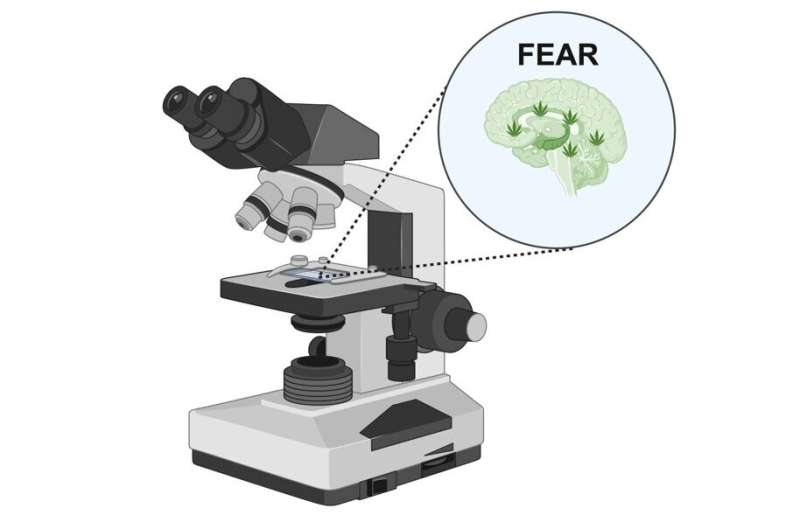October 24, 2023 feature
This article has been reviewed according to Science X's editorial process and policies. Editors have highlighted the following attributes while ensuring the content's credibility:
fact-checked
peer-reviewed publication
trusted source
proofread
Study unveils a cortico-amygdala neural substrate supporting fear extinction via endocannabinoids

Endogenous cannabinoids, or endocannabinoids for short, are lipid-based neurotransmitters known to support various physiological processes. Recent studies have hinted at the role of these neurotransmitters in so-called fear extinction, the process through which fear towards a particular stimulus diminishes after repeated and safe exposure to this stimulus.
While endocannabinoids have been found to support fear extinction, the neural underpinnings of their involvement remain poorly understood. Researchers at the National Institute on Alcohol Abuse and Alcoholism, Northwestern University Feinberg School of Medicine, and other research institutes in the United States recently carried out a study aimed at shedding further light on the neural circuits involved in endocannabinoid-supported fear extinction. Their paper, published in Neuron, identifies a neural substrate in the medial prefrontal cortex (mPFC) and amygdala that appears to support the endocannabinoid modulation of fear extinction.
"We and others have previously showed that augmenting endocannabinoid anandamide tone by inhibiting the degradation promotes extinction learning, highlighting the therapeutic potential of the endocannabinoid system and fatty acid amide hydrolase enzyme," Ozge Gunduz-Cinar, one of the researchers who carried out the study, told Medical Xpress.
"We also had accumulating data indicating the critical involvement of medial prefrontal cortex to basolateral amygdala (mPFC→BLA) pathway in extinction learning. Despite the well-established involvement of endocannabinoids in extinction learning, we still lacked the information on the precise neural circuit mechanisms underlying this effect."
Gunduz-Cinar and her colleagues essentially hypothesized that endocannabinoid mediated extinction is facilitated by the modulatory role of these neurotransmitters on mPFC→BLA neurons. To test this hypothesis, they conducted a series of experiments on adult mice, using a combination of techniques, including in vivo optogenetics, pharmacology, endocannabinoid biosensor imaging via fiber photometry, CRISPR-Cas9 mediated gene editing and slice electrophysiology.
"Our experiments revealed that the endocannabinoids are mobilized upon activation of the mPFC→BLA neurons to promote formation of extinction memory via signaling through their functional receptors and dynamically track the changes in the learned expectancy of the CS-shock association," Gunduz-Cinar explained. "Our findings advance the neural circuit mechanisms of endocannabinoid-mediated extinction learning and provide important evidence on therapeutic potential of targeting endocannabinoid system for extinction-deficit neuropsychiatric disorders."
The findings gathered by Gunduz-Cinar and her colleagues shed further light on the process through which endocannabinoids could facilitate fear extinction. As anxiety and conditioned fear responses are common symptoms of many psychiatric disorders, if validated in humans these results could have important clinical implications.
In the future, these researchers' work could pave the way towards the development of effective therapeutic interventions that promote fear extinction by targeting endocannabinoid receptors. In addition, their findings could inspire other teams of neuroscientists worldwide to further examine the involvement of the cortico-amygdala substrate delineated by Gunduz-Cinar and her collaborators in endocannabinoid-supported fear extinction.
"We now eagerly await the results of clinical trials testing the therapeutic potential of endocannabinoid-targeting medications in anxiety disorders and PTSD," Andrew Holmes, senior author of the paper, told Medical Xpress. "To inform these findings, it will be valuable to study whether individuals with underlying deficits in cortico-amygdala function differ in their responses to these medications."
More information: Ozge Gunduz-Cinar et al, A cortico-amygdala neural substrate for endocannabinoid modulation of fear extinction, Neuron (2023). DOI: 10.1016/j.neuron.2023.06.023
© 2023 Science X Network




















